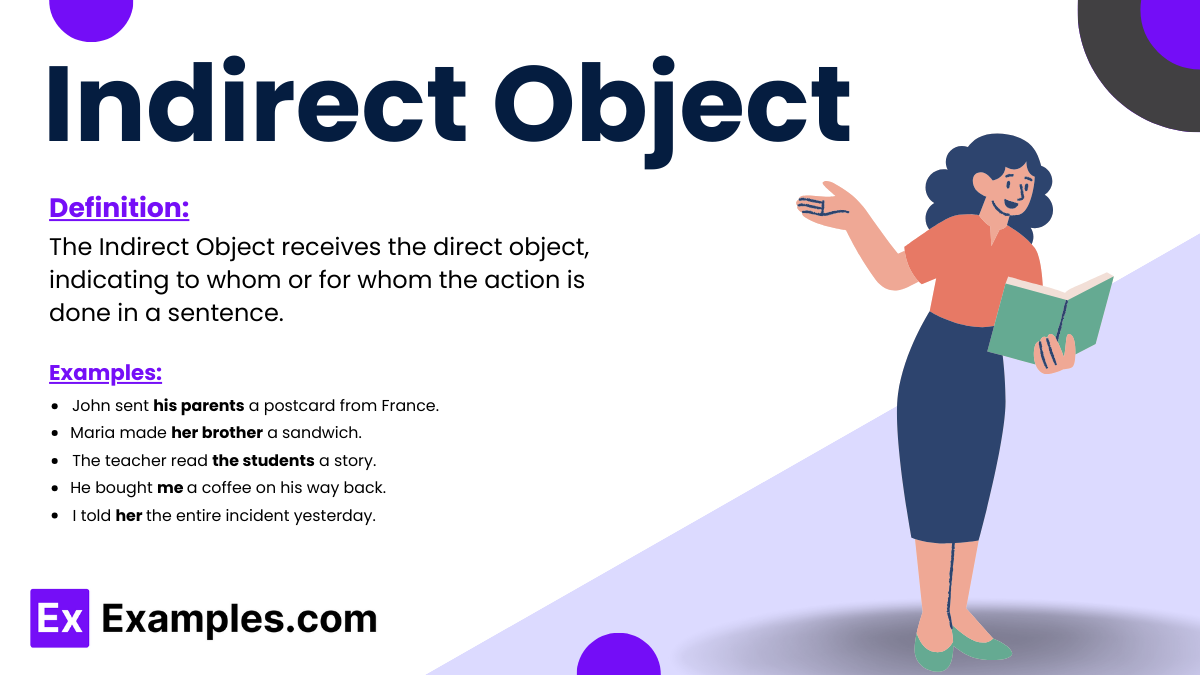50+ Indirect Object Examples
An indirect object in English grammar identifies to whom or for whom the action of the verb is performed, and who is receiving the direct object. It usually comes between the verb and the direct object. For example, in the sentence “She gave Jake a book,” “Jake” is the indirect object, as he is the recipient of the book, the direct object. Understanding indirect objects helps clarify the dynamics of sentence structure, enhancing both comprehension and communication skills. They are essential for constructing clear and effective sentences.
What is a Indirect Object?
An indirect object in a sentence identifies to whom or for whom the action of the verb is performed, typically placed between the verb and the direct object. It receives the direct object. For instance, in ‘She gave Jake a book,’ ‘Jake’ is the indirect object.
Functions of Indirect Object
The indirect object in English sentences plays a crucial role in conveying meaning by specifying the recipient of the action described by the verb. Here are the key functions of an indirect object:
- Identifying the Recipient: The indirect object determines who is receiving the direct object or benefiting from the verb’s action. For example, in “Lisa sent her friend a postcard,” ‘her friend’ is the indirect object receiving the postcard.
- Clarifying Sentence Meaning: By including an indirect object, a sentence specifies not just what action is taken but also whom it affects. This clarity enhances understanding and communication.
- Enhancing Sentence Structure: The presence of an indirect object allows for more complex and informative sentence constructions. It enables the speaker to incorporate additional information without resorting to multiple sentences or more cumbersome phrasing.
- Facilitating Emphasis on the Recipient: When a speaker wants to emphasize the recipient of an action rather than the action itself, the indirect object becomes a useful tool. For instance, “I baked my mother a cake” highlights ‘my mother’ as the primary focus of the action, rather than the cake.
Importance of Indirect Object
Indirect objects play a vital role in English grammar, enhancing both the complexity and clarity of communication. Here’s why they are important:
- Nuanced Communication: Indirect objects allow speakers to convey more nuanced information in a sentence. They make it possible to specify not only what action occurred but also who was affected by it. This adds depth to communication, allowing for more detailed storytelling and information sharing.
- Sentence Variety: Using indirect objects introduces a variety of sentence structures, making written and spoken language more engaging and less monotonous. This diversity can capture the listener’s or reader’s interest more effectively.
- Emphasis on Relationships: Indirect objects highlight the relationships between the action, the object, and the participants. For example, in the sentence “The teacher assigned the class homework,” ‘the class’ as the indirect object emphasizes that the action is directed towards the students, not just the homework itself.
- Enhanced Clarity: In complex sentences, indirect objects help clarify who is receiving the direct object, thereby avoiding potential confusion. This clarity is essential in both everyday communication and formal writing to ensure the message is understood as intended.
- Linguistic Efficiency: Indirect objects enable speakers and writers to express ideas succinctly, without needing additional sentences to clarify who is benefiting from or affected by an action. This efficiency is crucial in effective communication.
How to identify an Indirect Object?
Identifying an indirect object in English sentences is crucial for understanding how actions are directed in communication. Here’s a straightforward guide to help you pinpoint indirect objects easily:
- Locate the Action Verb: Start by finding the main action verb in the sentence. Verbs that imply an action being given or communicated, such as “give,” “send,” “tell,” “offer,” or “show,” often have indirect objects.
- Identify the Direct Object: Determine the direct object by asking “What?” or “Whom?” in relation to the verb. This is the person or thing directly affected by the action of the verb.
- Find the Indirect Object: Look for the indirect object, which answers “To whom?” or “For whom?” The indirect object usually precedes the direct object and follows the verb. For example, in the sentence “She gave her brother a gift,” “her brother” is the indirect object because he is the recipient of “a gift.”
- Check Sentence Structure: Indirect objects are typically positioned between the verb and the direct object without a preposition. However, if a preposition phrase with “to” or “for” replaces the indirect object and the sentence still makes sense, it can indicate the presence of an indirect object.
- Rearrangement Test: You can confirm whether a noun phrase is an indirect object by rearranging the sentence with a prepositional phrase. For instance, if “She gave her brother a gift” can be rephrased as “She gave a gift to her brother,” and retains the same meaning, “her brother” functions as the indirect object.
List of Indirect Objects
To help identify indirect objects in sentences, it’s useful to know the verbs that typically accompany them. Here’s a list of common verbs that often have indirect objects, demonstrating the pattern and aiding in recognizing indirect objects more easily:
| Verb | Sentence Example | Indirect Object |
|---|---|---|
| Give | He gave his friend a new book. | his friend |
| Send | She sent her parents a postcard from Italy. | her parents |
| Tell | The teacher told the class an interesting fact. | the class |
| Show | He showed me the way home. | me |
| Offer | She offered her neighbor some help. | her neighbor |
| Buy | I bought my brother a birthday gift. | my brother |
| Make | She made her friend a cup of tea. | her friend |
| Write | He wrote his colleague an email. | his colleague |
| Promise | They promised their teacher to study harder. | their teacher |
| Explain | The guide explained the tourists the history of the castle. | the tourists |
| Serve | The waiter served us our drinks. | us |
| Bring | He brought his boss the documents. | his boss |
| Read | She read the children a bedtime story. | the children |
| Teach | The instructor taught the students a new technique. | the students |
| Pay | She paid the artist a compliment. | the artist |
Indirect Object vs. Direct Object

| Aspect | Direct Object | Indirect Object |
|---|---|---|
| Definition | A direct object is the noun or pronoun that directly receives the action of the verb. | An indirect object is the noun or pronoun that receives the direct object, or benefits from the verb’s action. |
| Question Answered | Answers “What?” or “Whom?” in relation to the verb. | Answers “To whom?” or “For whom?” in relation to the verb and the direct object. |
| Position | Usually follows the verb directly in the sentence. | Typically placed between the verb and the direct object, often without a preposition. |
| Example Sentence | “She sent a letter.” (What did she send? A letter) | “She sent her brother a letter.” (To whom did she send the letter? Her brother) |
| Usage | Direct objects are essential to complete the meaning of verbs that require an object to convey a complete thought. | Indirect objects add additional detail and depth to the action by indicating who is affected by it, often enhancing emotional or relational nuances. |
| Dependency | Can exist in a sentence without an indirect object. | Cannot exist without a direct object when placed in a sentence structure. |
Indirect Object Pronouns
Indirect object pronouns in English are used to replace the noun phrases that would be the indirect objects in sentences. These pronouns help streamline sentences and avoid repetitive language. Here’s an overview of indirect object pronouns and how they are used:
List of Indirect Object Pronouns
- me (to/for me)
- you (to/for you) [singular and plural]
- him (to/for him)
- her (to/for her)
- it (to/for it)
- us (to/for us)
- them (to/for them)
Usage of Indirect Object Pronouns
Indirect object pronouns are placed before the verb in a sentence, or they can be attached to the infinitive. Here’s how they are typically used:
- Before the Verb:
- “She gave me the book.” (instead of “She gave the book to me.”)
- “I told him the story.” (instead of “I told the story to him.”)
- Attached to the Infinitive:
- “She needs to give us a chance.” (can also be structured as “She needs to give a chance to us.”)
- “Can you tell them to come?” (alternative structure: “Can you tell to them to come?”)
Examples in Sentences
- John bought her a gift.
- Replacement: “John bought her a gift.”
- We explained the rules to them.
- Replacement: “We explained them the rules.”
- Can you send me the document?
- Replacement remains: “Can you send me the document?”
Indirect Object with Preposition
In English grammar, indirect objects can often appear with prepositions, typically “to” or “for,” to clarify to whom or for whom the action of the verb is performed. Understanding how to use these prepositions correctly is crucial for constructing clear and accurate sentences.
Indirect objects without prepositions are typically placed directly after the verb and before the direct object. However, when the sentence structure changes or for clarity, prepositions are used to introduce indirect objects.
Key Points to Remember:
- Preposition “to” is used when indicating the direction of an action towards a person or entity.
- Example: “She sent an email to her manager.”
- Preposition “for” is used to show the benefit or on behalf of someone.
- Example: “He bought a gift for his sister.”
Examples in Sentences:
- To:
- “Can you explain the solution to me?”
- “He passed the message to the entire team.”
- For:
- “They made a reservation for their parents.”
- “I did this for you.”
When to Use Prepositions with Indirect Objects:
- Clarity: Adding a preposition can make it clear who the recipient of the action is, especially in complex sentences.
- “The officer returned the wallet to the man who had lost it.”
- Emphasis: Using a preposition can also emphasize the indirect object or make it stand out in the sentence.
- “She baked a cake especially for her friend.”
- Alternative Structures: In some cases, rephrasing a sentence with a preposition can alter the focus or style of the sentence.
- Standard: “She gave me the keys.”
- With Preposition: “She gave the keys to me.”
Examples of Indirect Object in Sentences
Understanding indirect objects within sentences helps clarify who is receiving the action or for whom the action is being done. Here are examples that illustrate the use of indirect objects in different contexts:
- John sent his parents a postcard from France.
- Indirect object: his parents
- Maria made her brother a sandwich.
- Indirect object: her brother
- The teacher read the students a story.
- Indirect object: the students
- He bought me a coffee on his way back.
- Indirect object: me
- I told her the entire incident yesterday.
- Indirect object: her
- Can you give us some advice on this matter?
- Indirect object: us
- The manager explained the new policy to the employees.
- Indirect object: the employees
- She left them a note on the table.
- Indirect object: them
- We showed our guests around the city.
- Indirect object: our guests
- They offered the visitors some refreshments.
- Indirect object: the visitors
There are many ways to improve sentence structure through the utilization of literary devices and techniques. One can improve the sentence’s specificity and provide further insight into the sentence’s subject, theme, context, and tone through the use of indirect objects and transitive verbs.
1. Effective Indirect Objects Example

college.cengage.com
2. Direct Objects and Indirect Objects

eaw.ouponlinepractice.com
3. Indirect Objects Representation and Access

arxiv.org
4. Indirect Objects Exercise Example

e-grammar.org
5. Editable Indirect Object Pronouns
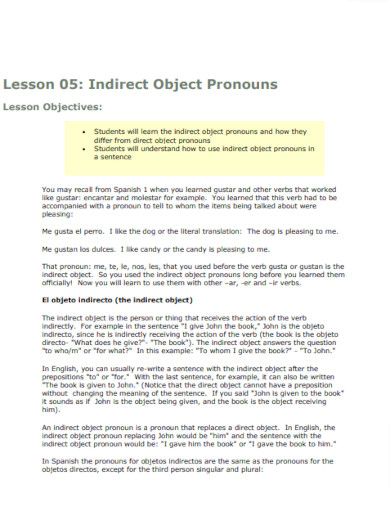
whitmoreschool.org
6. Indirect Objects and Subject Complements

ctalicuza.ro
7. Indirect Objects and Objects of the Preposition

somersetcanyons.com
8. Popular Indirect Objects Example

images.pcmac.org
9. Indirect Objects Complement Review Sheets

schoolwires.henry.k12.ga.us
10. Basic Indirect Object Example

marlingtonlocal.org
11. Dative Case as an Indirect Object Example

jenksps.org
12. Example Indirect Object

germanna.edu
13. Draft Indirect Object Example

mlz.innovasphere.com
14. Editable Indirect Object Example
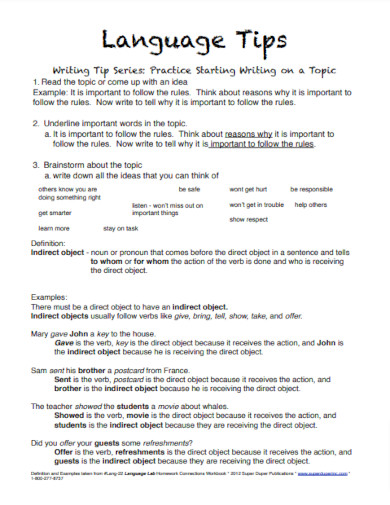
leonschools.net
15. Goals and Indirect Object Example

commons.und.edu
16. Creative Indirect Object Pronouns

livingston.org
17. Basic Indirect Object Pronouns

mooreschools.com
18. Indirect Object Worksheet Example

k5learning.com
19. Printable Indirect Object Example

ddanny2017.files.wordpress.com
20. Sample Indirect Object Pronouns

liberty.edu
21. Standard Indirect Objects Example
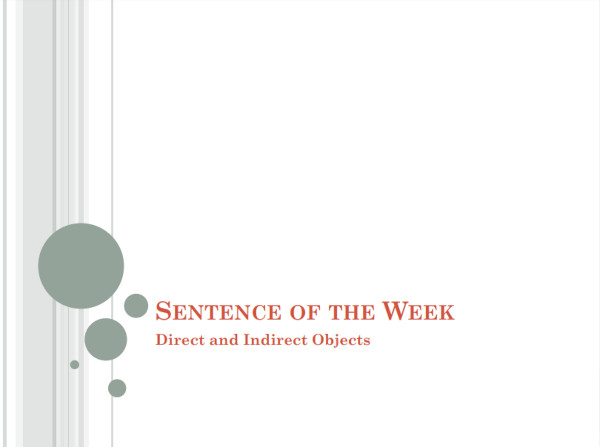
cbsd.org
22. Modern Indirect Objects Example
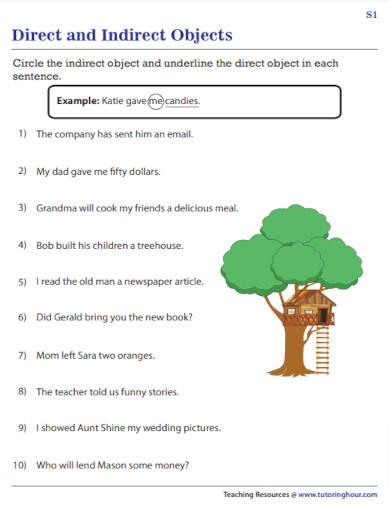
tutoringhour.com
23. Creative Indirect Objects Example
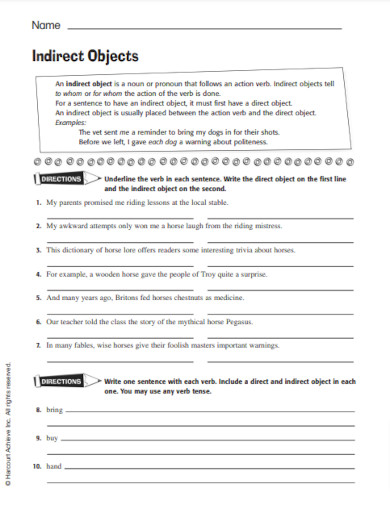
letread.com
24. Indirect Objects in the Grammatical Description of English

zir.nsk.hr
25. Indirect Object In Educated English

scholarworks.calstate.edu
26. Compound Indirect Objects Example

mrschroederhhs.weebly.com
27. Sample Indirect Object Example

chompchomp.com
28. Indirect Objects and Prepositional Phrases

superteacherworksheets.com
29. Complement Indirect Objects Example

stanhopeschools.org
30. Locating Objects and Complements

evergreen.edu
31. Indirect Objects Transitive and Intransitive Verbs

web.pdx.edu
How to Use an Indirect Object in a Simple Sentence
One can use indirect objects in a simple sentence to expound on specific contexts and provide a further explanation of the effects of an action or a cause-and-effect relationship. The indirect object requires the person to utilize a transitive verb, which is a type of verb that requires a direct object and may or may not include an indirect object. This type of verb acts as a direct juxtaposition of an intransitive verb that does not need a direct object.
Step 1: Select or Choose the Intention or Context of the Simple Sentence
Before writing or creating a simple sentence, you must select or choose the intention and context of your simple sentence. This intention and context will not only determine the whole sentence’s words and transitive verb but it will also affect the tone of the words.
Step 2: Create an Outline of a Simple Sentence Using an Indirect Object
You can opt to create an outline or outline format you will use for the simple sentence, which will incorporate the transitive verb, direct object, and indirect object. The format or outline will also help you ensure that you have the correct sentence structure with all the required elements.
Step 3: Write the Simple Sentence with an Indirect Object
After you have done and completed all of the steps above, you must now write a simple sentence that will utilize an indirect object. The usual simple sentence structure that incorporates this type of element is subject + transitive verb + indirect object + direct object.
Step 4: Edit or Proofread the Simple Sentence
When you have finished writing the simple sentence with the indirect object, you must now edit and proofread the contents of the simple sentence to ensure that it is grammatically correct and cohesive. You can also opt to have someone proofread your simple sentence.
FAQs
The indirect object is the receiver of the direct object through the use of the transitive verb; not all sentences that use transitive verbs have an indirect object. The direct object is the specific object or noun phrase that will receive a specific action from the subject of the sentence; all sentences that use transitive words have a direct object.What is the difference between an indirect object and a direct object?
The indirect object is the person receiving the direct object or the person that is directly receiving the effects of the transitive verb. A sentence that utilizes transitive verbs will have the indirect object directly after the transitive verb. To identify the indirect object, you must determine which noun phrase is receiving the direct object or the effects of the action.How do you identify an indirect object from a direct object?
A gerund is a type of noun that has a verb structure of verb + ing but acts as a noun, direct object, or indirect object. One can use gerunds as an indirect object when they are referring to a specific verb that the subject wants to describe or affect.What is a gerund, and how to use it as an indirect object?
An indirect object is a noun phrase one will use to accompany a transitive verb when one wants to establish a receiver of an action or the direct object. Proper utilization of the indirect object will ensure that the target market or audience understands the person that the subject is currently affecting or providing the direct object with.



